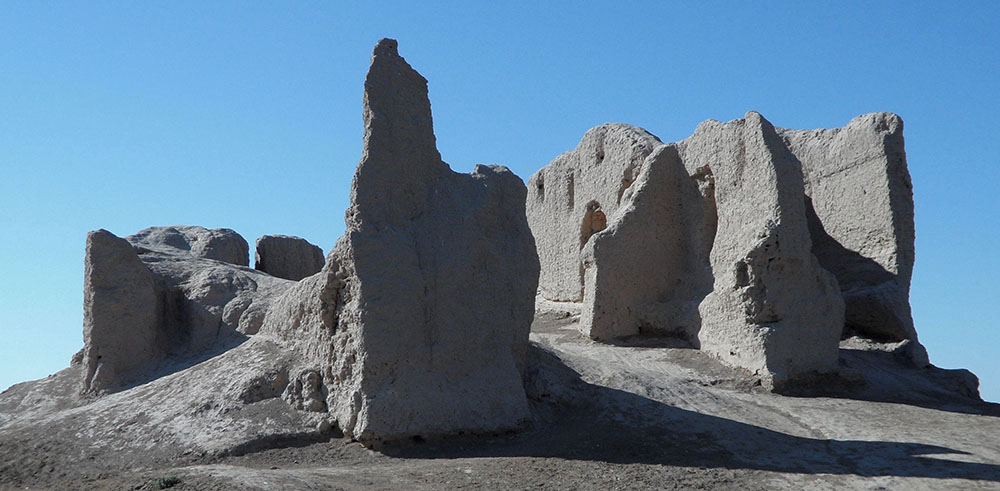Oasis Merv (40 km east of Mary) - one of the most ancient areas of Central Asia that have mastered irrigation - the first traces of the irrigation system in these regions belong to the period of the Bronze Age.  Therefore, it is not surprising that one of the largest cities of the ancient world grew up here - Merv (Margush, Margiana, Mouru or Maru in various sources). The origin of Merv is shrouded in secrets, one thing is known for sure - the first written records of it appear in the Avestan chronicles around the VIII-VI centuries. BC. Omar Khayyam, Al-Samani, Imamad Din-Isfahani and other great thinkers of the Middle Ages lived and worked here.
Therefore, it is not surprising that one of the largest cities of the ancient world grew up here - Merv (Margush, Margiana, Mouru or Maru in various sources). The origin of Merv is shrouded in secrets, one thing is known for sure - the first written records of it appear in the Avestan chronicles around the VIII-VI centuries. BC. Omar Khayyam, Al-Samani, Imamad Din-Isfahani and other great thinkers of the Middle Ages lived and worked here.
Modern ruins include at least five ancient settlements - Erk-Kala, Gyaur-Kala, Sultan-Kala, Abdullakhan-Kala and Bayramalikhan-Kala, surrounded by a wall and the ruins of other fortifications and religious buildings (the exact boundaries of the city are still not known) . Most of them are heavily destroyed, some of which are only very swollen earthen hills, but even with that in mind, Merv continues to be one of the most unique historical monuments. Today it is listed as a UNESCO World Heritage Site as the most well-preserved ancient center of the Great Silk Road.
Among the most interesting historical monuments are the mausoleum of Sultan Sanjar Dar-al-Ahir (1140 g. E.) Almost 40 meters  high in Sultan-Qala, the citadel of Shazriar-Ark, the ruins of the walls of Abdullakhan-Kala (XV century), the ruins of the fortress and the towers of Bayramalikhan-Kala, the ruins of the fortress of Kyz-Kala (VI-VII centuries AD), the mausoleums of Al-Hakim ibn Amir al-Jafari and Burayd ibn al-Hussein al-Islami (XV c., pilgrimage site), the mausoleum of Muhammad Ibn Zeid (XII century), Talkhatan-Baba complex with Talkhatan-Baba mausoleums, Imam Qasim, Imam Shafi and Imam Bakr of the Seljuk era, Yusuf Hamadani mosque (XI II c, modern reconstruction completed in the XIX c.), The ruins of the Erk-Kala fortress (VI c.), The ruins of a Christian temple and a Buddhist monastery in Gyaur-Kala (ancient Antioch Margiana), the ruins of the Beni Machan mosque ("Friday Mosque", VII-XII centuries), high walls similar to the structures of the buildings Big and Little Kyz-Kala, the mausoleum Kyz-Bibi, as well as numerous remains of baths, palaces, ceremonial halls and other structures.
high in Sultan-Qala, the citadel of Shazriar-Ark, the ruins of the walls of Abdullakhan-Kala (XV century), the ruins of the fortress and the towers of Bayramalikhan-Kala, the ruins of the fortress of Kyz-Kala (VI-VII centuries AD), the mausoleums of Al-Hakim ibn Amir al-Jafari and Burayd ibn al-Hussein al-Islami (XV c., pilgrimage site), the mausoleum of Muhammad Ibn Zeid (XII century), Talkhatan-Baba complex with Talkhatan-Baba mausoleums, Imam Qasim, Imam Shafi and Imam Bakr of the Seljuk era, Yusuf Hamadani mosque (XI II c, modern reconstruction completed in the XIX c.), The ruins of the Erk-Kala fortress (VI c.), The ruins of a Christian temple and a Buddhist monastery in Gyaur-Kala (ancient Antioch Margiana), the ruins of the Beni Machan mosque ("Friday Mosque", VII-XII centuries), high walls similar to the structures of the buildings Big and Little Kyz-Kala, the mausoleum Kyz-Bibi, as well as numerous remains of baths, palaces, ceremonial halls and other structures.
The mausoleum of the Dandankan mosque and Talkhatan-Baba also deserve attention (XII century, 30 km southeast of Merv), keshk (fortified house) Akuili-Koushuk (9th-13th centuries), single castle Haram-Ceshk (7 km north of Gyaur-Kala, 9th-13th centuries), Durnali site (25 km north of Gyaur-Kala, I-II cc.), Gebekly mound (32 km north-west of Gyaur-Kala). Many archaeological finds discovered during excavations of ancient cities are now on display in the beautiful United Historical Museum of Merv.
